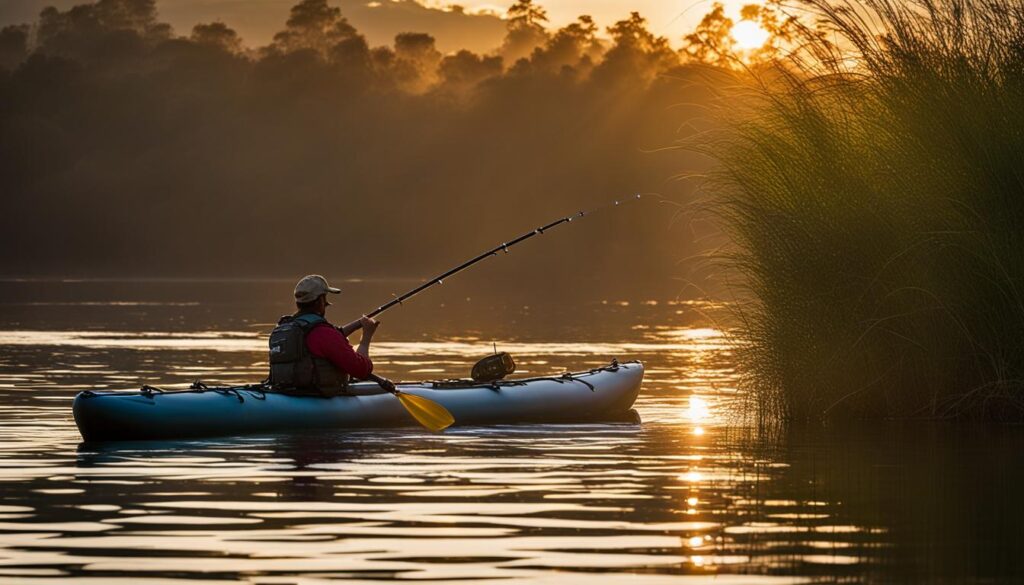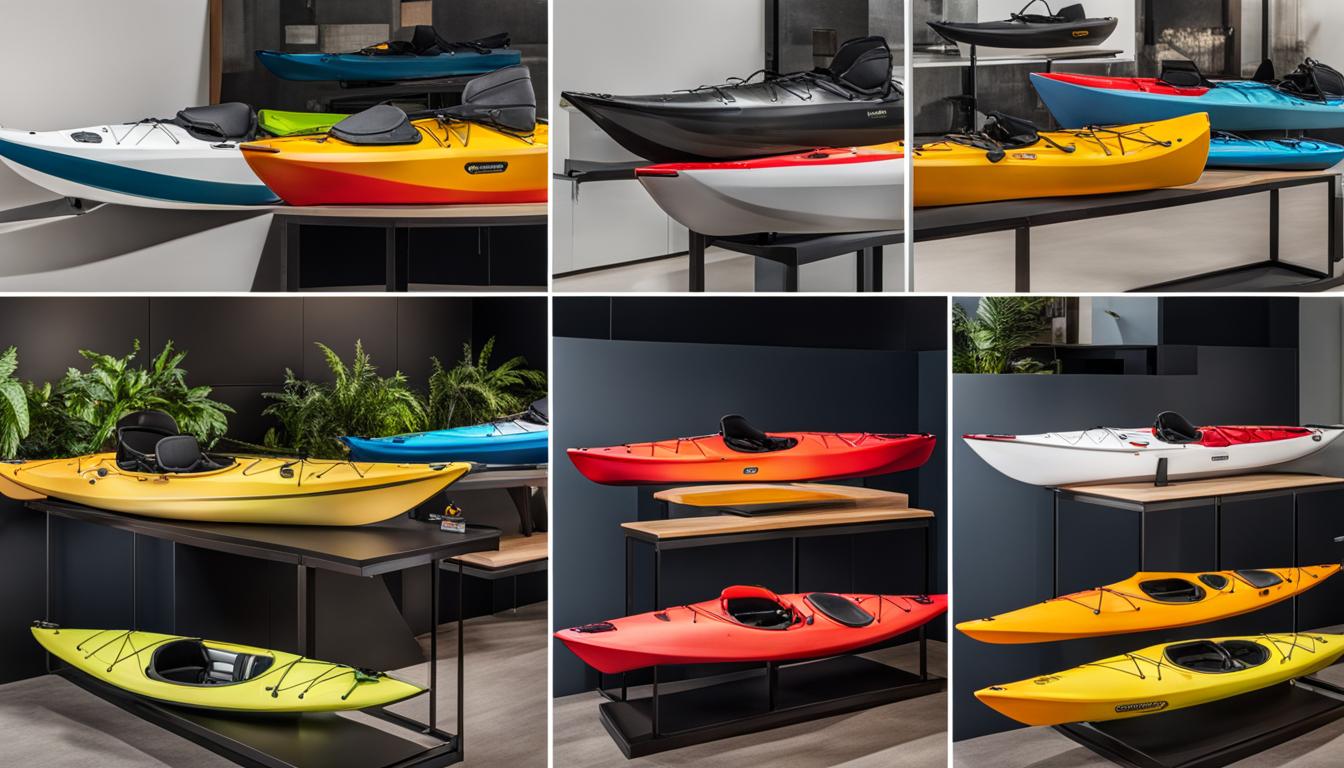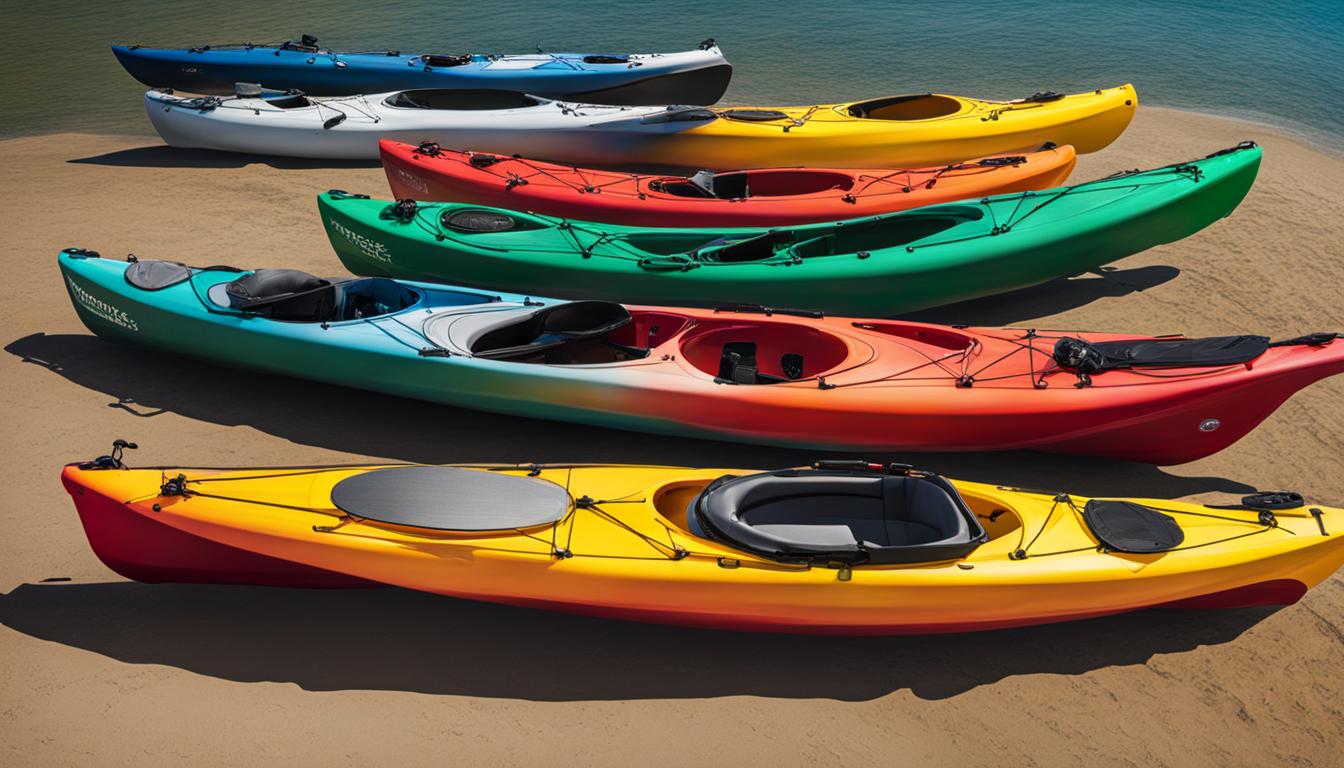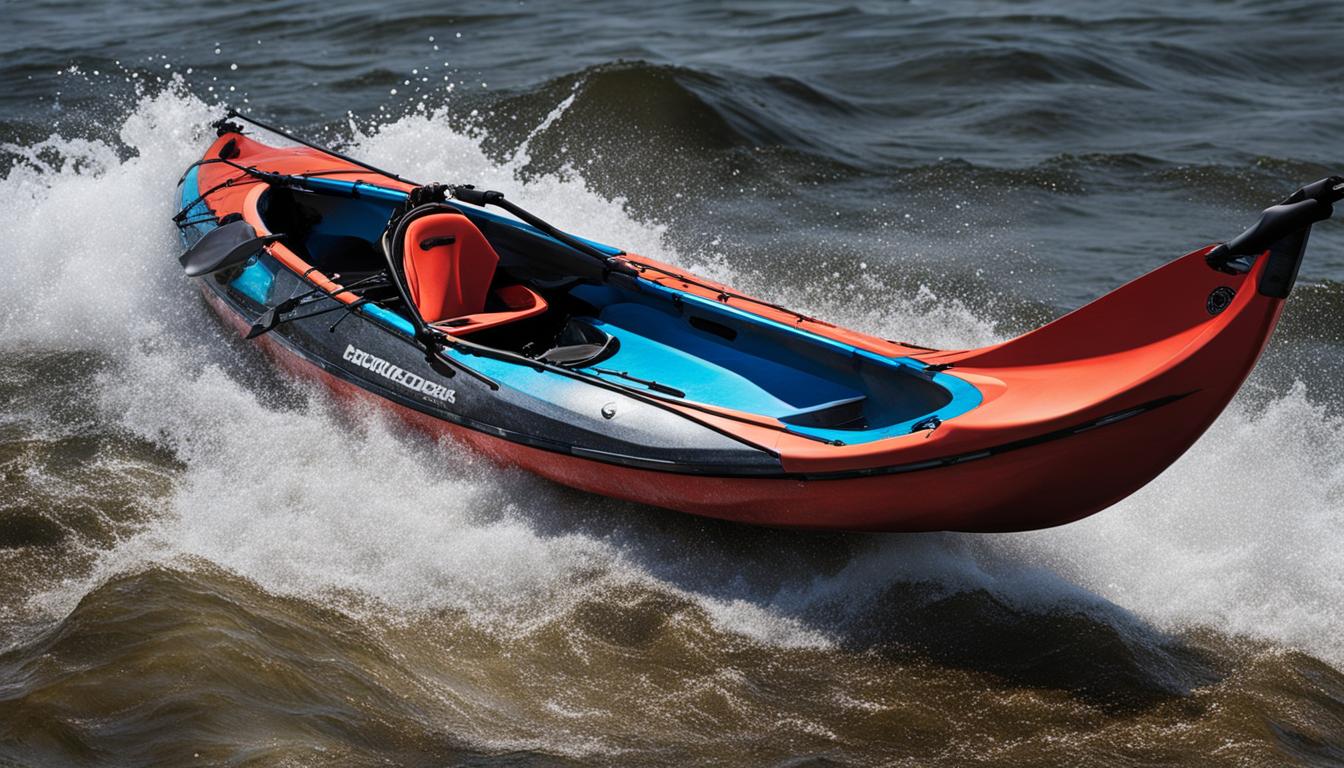When it comes to choosing the right fishing kayak, it’s important to consider factors such as the type of kayak (sit-on-top or sit-inside), the design (hull type, chines), the material used in construction, the weight of the kayak, storage options, and the availability of accessories like rod holders and mounting rails. Wilderness Systems and Old Town are two top brands known for their high-quality fishing kayaks. Let’s take a closer look at their fishing models and features.
Key Takeaways:
- Wilderness Systems and Old Town are leading brands in the fishing kayak industry.
- Consider factors such as kayak type, design, material, weight, storage options, and accessories when choosing a fishing kayak.
- Sit-on-top, sit-inside, and inflatable kayaks are the main types to choose from.
- The hull design and chines of a fishing kayak affect stability and maneuverability.
- Material and weight impact kayak performance and portability.
Types of Fishing Kayaks: Sit-on-Top, Sit-Inside, and Inflatable
When it comes to choosing the right fishing kayak, it’s important to consider the different types available. Sit-on-top kayaks, sit-inside kayaks, and inflatable kayaks all have their own advantages and considerations, catering to different fishing needs and preferences.
Sit-on-top Kayaks: Sit-on-top kayaks are popular among anglers due to their versatility and ease of use. They provide more storage options, allowing for additional accessories such as rod holders and fish finders. The open design of sit-on-top kayaks also makes it easier to get on and off the kayak, making them ideal for fishing in shallow waters or for those who prefer a more comfortable sitting position.
Sit-inside Kayaks: Sit-inside kayaks offer better protection from the elements, keeping you drier and warmer during your fishing trips. They generally have more storage space, making them suitable for longer fishing excursions. Sit-inside kayaks also provide a lower center of gravity, enhancing stability in rougher waters and making them a preferred choice for kayak fishing in colder climates.
Inflatable Kayaks: Inflatable kayaks are portable and convenient, perfect for anglers who like to fish in remote or hard-to-reach areas. They are lightweight and easy to transport, making them a popular choice for those who don’t have much storage space. Inflatable kayaks can be quickly inflated and deflated, allowing for easy setup and pack-up. While they may not offer the same level of stability as hard-shell kayaks, they are still a practical and cost-effective option for casual anglers or those who prioritize portability.

As you consider the type of fishing kayak that best suits your needs, think about factors such as the fishing environment, storage requirements, ease of transportation, and personal preferences. Each type of kayak has its own unique features and benefits, so take the time to research and test out different models to find the perfect fit for your fishing adventures.
Hull Design and Chines: Stability and Maneuverability
When it comes to choosing a fishing kayak, the hull design and chines play a crucial role in determining its stability and maneuverability on the water. The hull design refers to the shape of the bottom of the kayak, while chines are the lateral lines that run from the tip to the stern. Understanding these features is essential for selecting the right kayak to suit your needs.
Most fishing kayaks have a compact length and offer good primary stability, which refers to the kayak’s steadiness in calm water. This makes them suitable for various fishing activities, including casting and reeling in fish. The chines, whether hard or soft, also contribute to the overall hull design.
Hard Chines
Hard chines have a creased appearance, providing several benefits for anglers. They enhance speed and tracking, allowing you to cover more distance efficiently. Hard chines also contribute to the kayak’s primary stability, giving you a sturdy platform to fish from. These kayaks are ideal for anglers who prioritize speed and stability in their fishing adventures.
Soft Chines
On the other hand, soft chines have a more rounded transition from the bottom of the kayak to the sides. This design offers enhanced secondary stability, which is the kayak’s ability to remain stable in choppy or rough waters. While they may sacrifice some speed, soft chines provide excellent stability, making them a suitable choice for open-water fishing.
Ultimately, the choice between hard and soft chines depends on your fishing preferences and the type of water you’ll be fishing in. Consider factors like the conditions you’ll encounter, the level of stability you require, and the maneuverability you desire. This will help you select a fishing kayak with the right hull design and chines to make your fishing experience enjoyable and successful.

| Chine Type | Advantages | Considerations |
|---|---|---|
| Hard Chines | Enhanced speed and tracking Improved primary stability |
May sacrifice some maneuverability Less suitable for rough waters |
| Soft Chines | Excellent stability in rough waters Enhanced secondary stability |
Slower speed compared to hard chines Less efficient for long-distance paddling |
Material and Weight: Performance and Portability
When it comes to choosing a fishing kayak, the material used in its construction is an important factor to consider. The material not only affects the kayak’s performance but also its durability and weight. Two commonly used materials in fishing kayaks are rotational molding and the fusion method. Rotational molding is a process that produces kayaks with a sturdy and durable construction. These kayaks are resistant to leaks and cracks, making them ideal for rugged fishing adventures. On the other hand, the fusion method involves fusing two halves of the kayak together. While this method can result in a sleeker design, the impact resistance may be compromised.
Another option to consider is composite-framed kayaks. These kayaks are made from materials such as fiberglass or carbon fiber, which are known for their lightweight properties. Composite kayaks offer excellent performance on the water and are a popular choice among experienced anglers. However, it’s important to note that composite-framed kayaks tend to come with a higher price tag compared to kayaks made with other materials.
The weight of a fishing kayak is also an important consideration, especially if you plan on transporting it frequently. Lightweight kayaks are easier to carry and load onto your vehicle, making them more convenient for anglers who enjoy exploring different fishing spots. However, it’s essential to strike a balance between weight and stability. While a lightweight kayak may be easier to transport, it may be less stable in certain conditions. Consider your own physical capabilities and the specific requirements of your fishing adventures when deciding on the weight of your kayak.
Table: Comparison of Fishing Kayak Materials
| Material | Construction Method | Performance | Durability | Weight |
|---|---|---|---|---|
| Rotational Molding | Roto-molded | Sturdy and durable | Resistant to leaks and cracks | Relatively heavier |
| Fusion Method | Fused halves | Sleek design | May compromise impact resistance | Relatively lighter |
| Composite-Framed | Fiberglass or carbon fiber | Excellent performance | Varies depending on materials | Lightweight |
Considering the material and weight of a fishing kayak is essential for finding the right balance between performance and portability. Whether you prefer the sturdiness of a rotomolded kayak, the sleek design of a fusion-constructed kayak, or the lightweight nature of a composite-framed kayak, there is a material that suits your fishing style and needs. Take into account the specific conditions and requirements of your fishing adventures to make an informed decision that will enhance your overall fishing experience.
Storage and Accessories: Essential Features for Fishing Kayaks
When it comes to choosing a fishing kayak, storage and accessories play a vital role in enhancing your fishing experience. Having the right storage options and essential accessories can make your fishing trips more convenient and productive. In this section, we will explore the various storage features and accessories that are crucial for any fishing kayak.
Storage Options
Adequate storage space is essential when it comes to fishing kayaks. It allows you to store your catch, fishing equipment, and other necessary items while keeping them easily accessible. The type of kayak you choose will determine the storage options available to you.
One common storage feature found in fishing kayaks is a tankwell, which is a large open area located at the rear of the kayak. This space allows you to store items such as a tackle box, cooler, or even a live bait well. Sit-on-top kayaks often have larger tankwells compared to sit-inside kayaks, providing more storage capacity.
In addition to tankwells, many fishing kayaks also feature enclosed hatches. These hatches provide a secure and dry storage area for items that need to be protected from water or harsh weather conditions. They are typically located in the bow and/or stern of the kayak and offer a more organized storage solution.
Essential Accessories
Accessories are another important aspect to consider when choosing a fishing kayak. They can greatly enhance your fishing experience and make your time on the water more enjoyable.
Rod holders are an essential accessory for any angler. They allow you to secure your fishing rods while paddling or when you need both hands free for other tasks. Some kayaks come with built-in rod holders, while others have mounting options where you can attach aftermarket rod holders.
Mounting rails are another accessory to look out for. These rails provide a versatile platform for attaching additional accessories such as fish finders, GPS units, camera mounts, or extra rod holders. They offer customization options and allow you to personalize your fishing kayak according to your specific needs.
Paddle holders are also worth considering. They provide a convenient way to secure your paddle when you’re not actively paddling or fishing. Paddle holders are typically located on the sides of the kayak and ensure that your paddle is easily accessible whenever you need it.
| Storage Features | Accessories |
|---|---|
| Tankwell | Rod Holders |
| Enclosed Hatches | Mounting Rails |
| – | Paddle Holders |
Having the right storage options and essential accessories can greatly enhance your fishing experience. Consider the storage features that meet your specific needs, whether it’s a large tankwell or enclosed hatches for secure storage. Additionally, look for kayaks with built-in or customizable accessories such as rod holders, mounting rails, and paddle holders. By choosing a fishing kayak with the right storage and accessories, you’ll be well-prepared for successful and enjoyable fishing adventures.
Conclusion
When it comes to finding the best kayak brands for fishing, you can’t go wrong with Wilderness Systems and Old Town. These reputable brands have garnered positive angler reviews for their reliable performance and durable setups.
Before making your decision, take into account the specific needs of your fishing adventures. Consider factors such as fishing kayak performance and stability, as well as the availability of kayak fishing equipment.
Both Wilderness Systems and Old Town offer a variety of models that cater to different fishing styles and preferences. From sit-on-top kayaks for added storage options to sit-inside kayaks for enhanced stability, you’ll find a kayak that suits your needs.
Investing in a high-quality fishing kayak from Wilderness Systems or Old Town will not only enhance your fishing experience but also increase your chances of landing that big catch. So get out on the water and enjoy the thrill of fishing with confidence and convenience.
FAQ
What factors should I consider when choosing a fishing kayak?
Factors to consider include the type of kayak (sit-on-top or sit-inside), design (hull type, chines), material used, weight, storage options, and availability of accessories like rod holders and mounting rails.
What are the different types of fishing kayaks?
There are sit-on-top kayaks, sit-inside kayaks, and inflatable kayaks. Pedal kayaks are also available for hands-free fishing.
How does the hull design affect the kayak’s stability and maneuverability?
The hull design plays a crucial role in stability and maneuverability. Most fishing kayaks have good primary stability, and the chines (hard or soft) affect stability, tracking, and maneuverability.
What materials are fishing kayaks made of, and how does weight affect performance?
Fishing kayaks are commonly made using rotational molding, which results in a sturdy and leak-resistant kayak. Composite-framed kayaks made of fiberglass or carbon fiber are lightweight but more expensive. The weight of a kayak affects its portability and stability in different conditions.
What storage options and accessories are important for fishing kayaks?
Storage options include tankwells and enclosed hatches. Accessories like rod holders, mounting rails, and paddle holders are important for hands-free fishing and convenience.
What are the top fishing kayak brands to consider?
Wilderness Systems and Old Town are top brands known for their high-quality fishing kayaks. Both brands offer a range of models with innovative features and performance on the water.





